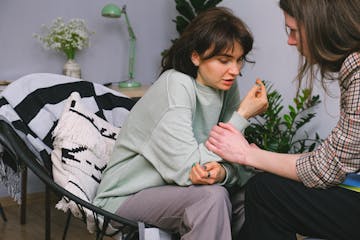Syncope, commonly known as fainting, is a transient episode of loss of consciousness that is usually short-lived and may be accompanied by a fall. This condition can be worrying for both the person experiencing it and those who witness it. In this article, we will explore the symptoms, types, causes and what to do in case of syncope.
Symptoms of Syncope
Syncope It can occur suddenly and without warning. Common symptoms that people who are about to faint may experience include:
- Dizziness or feeling weak
- Loss of vision or blurred vision
- Nausea
- Cold, clammy skin
- Loss of balance
In addition to these physical symptoms, the person who is about to faint may feel anxiety, rapid heart palpitations, or a feeling of impending fainting. It is essential to recognize these signs in order to act quickly and prevent injuries in the event of a fall.
Types of Syncope
Vasovagal Syncope
Vasovagal syncope is one of the most common types of fainting and are usually related to a specific trigger, such as seeing blood or experiencing an emotionally stressful situation. In this type of syncope, there is a temporary decrease in blood flow to the brain due to an exaggerated response of the autonomic nervous system.
Cardiogenic Syncope
Cardiogenic syncope is caused by a problem underlying heart disease that affects the heart's ability to effectively pump blood to the brain. This type of fainting may be related to heart rhythm disorders, heart valve diseases, or structural heart disease.
Neurological Syncope
Neurological syncope occurs due to a neurological disorder underlying that affects the functioning of the central nervous system. It may be associated with conditions such as epilepsy, stroke or neurodegenerative disorders.
Other Types of Syncope
In addition to the types mentioned, there are other less common causes of syncope, such as syncope due to Orthostatic hypotension (drop in blood pressure when changing position), syncope due to malignant hypertension, psychogenic syncope and syncope due to hyperventilation, among others.
Causes of Syncope
Syncope can be Triggered by a variety of factors that affect the normal regulation of blood pressure, blood flow, and heart and brain function. Some of the most common causes of syncope include:
1. Triggering Factors
As mentioned above, certain triggers, such as emotional stress, the sight of blood, severe pain, or standing for prolonged periods, can cause an episode of vasovagal syncope in some people.
2. Cardiac Disorders
Heart rhythm disorders, such as bradycardia or tachycardia, can interfere with the heart's ability to pump blood efficiently, which can lead to cardiogenic syncope.
3. Vascular Processes
Sudden changes in blood pressure, as in the case of orthostatic hypotension, can cause a temporary decrease in blood flow to the brain, triggering syncope.
4. Neurological Disorders
Neurological disorders that affect the control of consciousness and blood pressure, such as epilepsy or migraine, may be responsible for episodes of neurological syncope.
What to do before a Syncope Episode
If you witness someone who is about to faint or who has lost consciousness, it is important to act calmly and quickly to help the person and prevent injury. Below are the steps you should follow when faced with an episode of syncope:
1. Stay Calm
The first thing is to stay calm and try to reassure the person who is experiencing syncope, as well as those around you.
2. Place the Person in a Safe Position
If the person has lost consciousness, place him or her in a supine (face up) position in a safe place with the head slightly elevated to facilitate blood circulation to the person. brain.
3. Loosen Tight Clothing
Make sure the clothing around the person's neck and chest is loose to facilitate breathing and blood flow.
4. Check the Airway
Check that the person's airway is clear and free of obstructions that could make breathing difficult.
5. Monitor Vital Signs
If you are trained to do so, monitor the vital signs of the person who has lost consciousness, such as breathing and pulse, and if necessary, start CPR (cardio-pulmonary resuscitation). ) while you wait for the arrival of medical help.
6. Call Emergency Services
If the person does not regain consciousness within a few minutes, call emergency services so they can evaluate and provide necessary medical assistance.
Prevention of Syncope
If you experience recurrent episodes of syncope or have a family history of fainting, it is important to see a doctor to determine the underlying cause and receive a proper diagnosis. Some measures you can take to prevent syncope include:
1. Maintaining Adequate Hydration
Drinking enough water and avoiding dehydration can help keep blood pressure stable and prevent episodes of syncope.
2. Avoid Triggering Factors
Identify and avoid triggers that may cause an episode of syncope, such as emotional stress, lack of sleep, or standing for prolonged periods.
3. Have a Healthy Diet
A balanced diet rich in fruits, vegetables, whole grains and lean proteins can help maintain cardiovascular health and prevent fainting related to blood pressure or blood sugar problems.
4. Perform Moderate Exercise
Keeping physically active with a regular exercise program can strengthen the heart and improve blood circulation, reducing the risk of syncope in some people.
5. Follow Medical Recommendations
It is essential to follow medical recommendations and treatments prescribed by a health professional if a specific cause of syncope, such as cardiac or neurological disorders, has been identified.
Conclusion
Syncope is an episode of loss of consciousness that can be alarming both for the person experiencing it and for those who witness it. It is important to know the symptoms, types, causes and what to do in case of syncope in order to act appropriately and provide the necessary help to those who need it. If you experience recurrent fainting or have concerns related to syncope, do not hesitate to consult a healthcare professional for proper diagnosis and treatment.
Author: Psychologist José Álvarez


